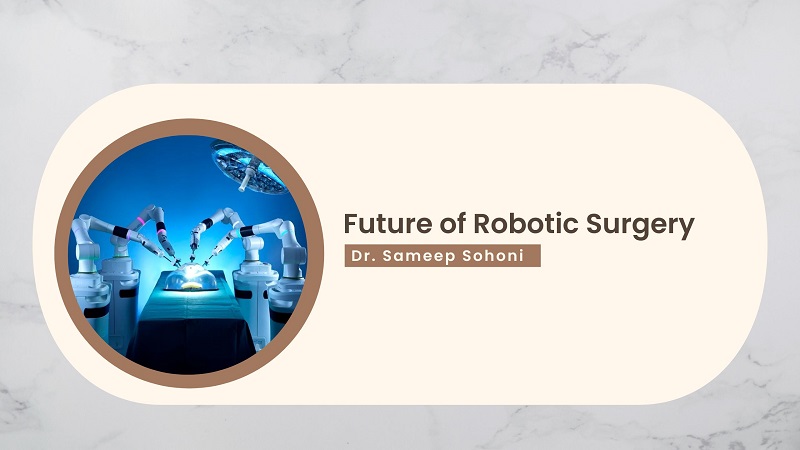The Future of Robotic Surgery

In the dynamic world of medical advancements, the trajectory of surgical treatments is experiencing deep and revolutionary change. This transformation is more than just a subtle shift; it is an enormous shift driven by an unwavering commitment to precision and efficiency. At the head of this
revolutionary wave is robotic surgery, a cutting-edge technology that is altering the landscape of surgical practice. However, its significance goes far beyond the operating room, serving as a catalyst for the whole medical sector to enter an era of extraordinary growth and innovation.
The role of robotic surgery as a transformational force is not just to reshape procedural techniques, but also to profoundly modify how we see and approach healthcare. The precision and efficiency it brings to the surgical arena heralds a new era in which patient outcomes are optimized, recuperation times are reduced, and the boundaries of what is possible in medicine are pushed even further. As a result, the impact of robotic surgery is much beyond the operating room but throughout the medical community, encouraging a culture of continual development and cutting-edge advancements.
I. History of Robotic Surgery
The origins of robotic surgery may be traced back to the early 2000s, when the da Vinci Surgical
System was first introduced. Originally designed for military applications, the da Vinci System evolved into a game-changing technology that was quickly adopted in the medical field. Its introduction into the healthcare industry marked the start of a new era characterized by minimally invasive procedures and increased surgical precision.
The da Vinci Surgical System, with robotic arms controlled by a surgeon-operated console, transformed traditional surgical procedures. Patients benefited from smaller incisions, less scarring, and shorter recovery times thanks to this invention. The system’s precision and maneuverability dramatically improved surgeon capabilities, giving them unprecedented control and dexterity during procedures.
II. Advantages of Robotic Surgery
The numerous benefits of robotic surgery range from precision and safety to recovery times and patient happiness.
- Surgical Precision and Accuracy: – Robotic technologies enable surgeons to accomplish difficult operations with greater The utilization of robotic arms and modern imaging technologies allows for accurate motions and real-time visualization of the surgical site.
- Reduced Risk of complications: – Robotic systems provide precision, reducing the risk of problems during – Surgeons may navigate complicated anatomical structures more safely, minimizing errors and consequences.
- Minimally Invasive Nature: – Robotic surgery requires lesser incisions compared to traditional open Minimally invasive techniques cause less stress to the surrounding tissues, reduced discomfort, less scarring, and quicker recovery times.
- Shorter Recovery Times: – The minimally invasive technique combined with robotic precision leads to faster recovery times for patients. Reduced trauma to tissues and organs leads to speedier healing and return to normal
- Robotic systems enhance surgeon capabilities by giving a wider range of motion and Surgeons can perform difficult maneuvers with more ease, resulting in better outcomes across a variety of medical specialties.
- Collaboration between surgeons and robotic systems leads to a symbiotic partnership that improves overall capabilities. Surgeons operate the robotic instruments, while the system provides stability, precision, and extra capabilities to supplement the surgeon’s
- Optimal Outcomes in Specialized treatments: – Robotic surgery is very effective in specialized medical treatments like cardiac surgery, urology, and gynaecology. The precision and control provided by robotic devices are especially useful in delicate and sophisticated procedures.
- Improved Patient Satisfaction: – Reduced complications, shorter recovery periods, and better surgical outcomes lead to increased patient satisfaction. Patients typically report less pain and discomfort, resulting in a more positive overall surgery
III. Future of Robotic Surgery in India:
The future of robotic surgery in India is shaping up as an exciting frontier, marked by spectacular advances and ground-breaking breakthroughs. Visionary practitioners such as Dr. Sameep Sohoni, a well-known robotic joint replacement surgeon in Thane, Mumbai, have not only raised the standard of treatment but also played a critical part in placing India as a global hub for new medical techniques.
Dr. Sameep Sohoni’s contributions to robotic surgery are truly innovative. As a top expert in joint
replacement surgery, he has used robotic technology to transform traditional treatments into less invasive miracles. The demand for such procedures is rapidly increasing, driven by the various benefits they offer, such as reduced recovery times.
One of the primary factors driving the expansion of robotic surgery in India is patients’ growing awareness of the benefits of minimally invasive procedures. As patients become more
knowledgeable about these operations, the demand for qualified robotic surgeons like Dr.Sameep Sohoni grows. Patients are actively looking for medical practitioners that use cutting-edge technologies to improve the precision and effectiveness of surgical interventions.
Dr. Sameep Sohoni’s impact extends beyond the operating room; he is actively involved in educating and training the next generation of surgeons on robotic procedures. By sharing his knowledge and expertise, he helps to expand the talent pool capable of executing advanced robotic surgeries.
Patients from all around the world are increasingly looking to India as a feasible option for receiving cutting-edge healthcare treatments. This not only benefits the country’s healthcare industry, but it also encourages international collaborations and partnerships, thereby facilitating the sharing of knowledge and expertise in the field.
As the future unfolds, the trajectory of robotic surgery in India appears to be on an exponential upward trend. With continual technological breakthroughs, there is enormous potential for even more advanced robotic systems and operations. Visionary practitioners, such as Dr. Sameep Sohoni, have not only raised the standard of care, but also established the country as a global hub for new medical procedures.
IV. Future of AI in Surgery
The synergistic interplay between artificial intelligence (AI) and medical developments is poised to revolutionize surgery’s future. Dr. Sameep Sohoni (Top orthopedic Doctor in Thane), an influential expert in the field, predicts a paradigm shift in which AI plays a critical role in designing personalized treatment plans and predictive analytics, ushering in a new era of patient-centered healthcare.
One of AI’s primary capabilities is its ability to quickly analyze large datasets and extract relevant insights. In the context of surgery, this means a major improvement in decision-making processes. AI can analyze patient data, medical histories, and current health measurements to create personalized treatment regimens that address each individual’s unique needs.
AI algorithms can predict post-operative outcomes, allowing healthcare practitioners to treat any difficulties before they arise. This foresight not only improves patient outcomes, but also helps to optimise healthcare resources.
V. Advancements in Robotic Surgery:
In the ever-changing environment of medical innovation, the unwavering pursuit of perfection in robotic surgery has become a sign of progress. Dr. Sameep Sohoni (Best Robotic Joint Replacement Surgeon in Mumbai) is a luminary in this profession… particularly in joint replacement surgery, where his efforts have established new standards for surgical quality. His relentless commitment to pushing the limits of what is possible has moved the field ahead, changing the face of patient care.
The use of cutting-edge robotic technology has revolutionized joint replacement surgery. These cutting-edge technologies provide previously inconceivable levels of precision, allowing surgeons to maneuver with remarkable accuracy. The end result is not only increased surgical precision, but also an expansion of procedural options.
Patients can now benefit from surgeries that are not only safer, but also better suited to their specific needs. The ongoing innovations that have defined robotic surgery demonstrate the field’s fluidity.
Continuous efforts to improve techniques and increase the breadth of applications demonstrate a commitment to remaining at the forefront of medical innovation.

 Previous Post
Previous Post Next Post
Next Post
